
 Fedspeak limits November damage to equities
By R. Mark Rogers, Senior Economist, Econoday
Fedspeak limits November damage to equities
By R. Mark Rogers, Senior Economist, Econoday
November 30, 2007

This past week equities rebounded sharply after sharp declines throughout much of November and notably the prior week. The lift in stocks was despite further weakness in housing and was primarily due to key Federal Reserve officials strongly hinting that the Fed will be cutting interest rates on December 11 at its policy meeting. Injections of capital into key financial firms also played key roles for boosting equities.
Equities began last week by dropping sharply on Monday and meeting the technical definition of a correction – falling 10 percent from a high. The Dow dropped 237 points for the day with other major indexes posting declines of similar magnitude. The markets were racked by concerns that subprime problems would be worsening. News that the New York Fed would be making loans for atypically long terms to help banks with year-end cash needs also raised concern about recession. But on Tuesday equities turned back up from Monday’s correction levels as bargain hunters swooped in and as the Abu Dhabi Investment Authority announced a $7.5 billion investment into Citigroup. The cash injection helped restore confidence as did a drop in oil prices. But the big lift in equities came from comments by Federal Reserve Vice Chairman Donald Kohn. He took exception to recent comments by some regional Fed bank presidents that the markets should not expect a rate cut on December 11. Kohn stated that the Fed should be “nimble” in responding to economic data and changes in the financial system. He indicated that the economy should not be punished just to teach a lesson to individual investors. The Dow jumped 331 points for the day. Fed Chairman Ben Bernanke spoke Thursday evening and essentially corroborated the view that the Fed needs to be “exceptionally alert and flexible” as the Fed evaluates appropriate policy. On Friday, markets actually were boosted by a soft personal income report which was seen as boosting odds of a Fed rate cut on December 11.

Last week, major indexes were up sharply: the Dow, up 3.0 percent; the S&P 500, up 2.8 percent; the Nasdaq, up 2.5 percent; and the Russell 2000, up 1.7 percent.

Despite a strong finish, November was a dismal month for equities – especially for the small caps and tech stocks. For November net, major indexes were down significantly: the Dow, down 4.0 percent; the S&P 500, down 4.4 percent; the Nasdaq, down 6.9 percent; and the Russell 2000, down 7.3 percent.
Year-to-date, the Dow is up 7.3 percent; the S&P 500, up 4.4 percent; and the Nasdaq, up 10.2 percent. The Russell 2000 is down 2.5 percent since year end.
Rates on Treasuries slipped somewhat last week primarily due to flight to quality and also on increased expectations of a Fed rate cut in December. Rates fell by double-digit basis points on Monday as subprime concerns and a sharp drop in equities led to heavy flight to safety. Rates largely reversed on Tuesday and Wednesday as a surge in stock prices undercut Treasury prices. Rates softened during the week on release of weak new and existing home sale numbers and on sluggish personal income and personal spending. A sharp drop in oil prices on Friday also helped rates dip at week’s end.
Treasury yields were down last week as follows: 3-month T-bill, down 7 basis points; the 2-year note; down 6 basis points; the 3-year note; down 5 basis points; the 5-year note, down 2 basis points; the 10-year bond, down 6 basis points; and the 30-year bond, down 5 basis points.
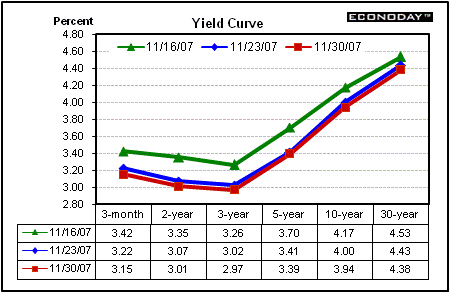
Rates were down somewhat last week on flight to quality, increased expectations of Fed easing, and a drop in oil prices.

Oil prices last week came off recent historical highs approaching $100 per barrel for West Texas Intermediate spot. The biggest moves came Tuesday and Wednesday at prices fell over $3 per barrel on Tuesday and almost $4 per barrel on Wednesday. Weighing on prices for the most part were reports that OPEC would be boosting oil production by anywhere from 500,000 to 1 million barrels per day. OPEC is scheduled to meet December 5. Also, pushing prices down were concerns over recession in the U.S. and Wednesday’s inventory report showed inventories down but notably less than expected. Prices did get a boost on Thursday after an explosion in northern Minnesota to a set of pipelines carrying oil from Canada. Prices spiked to over $95 per barrel on intraday trading until it was announced that three of the four pipelines were undamaged and that the fourth would be repaired in a few days, leaving only a 39 cent per barrel gain for the day. Further talk of OPEC production hikes pushed prices down sharply on Friday.
The spot price for West Texas Intermediate plummeted $9.47 per barrel for the week to close at $88.71 per barrel, $10.17 below the record high of $98.88 per barrel set November 20th.
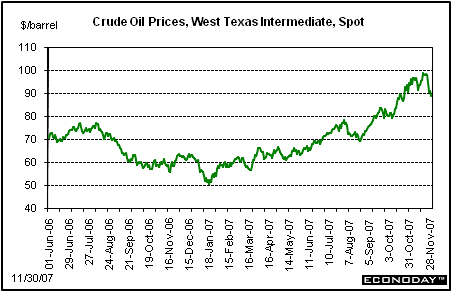
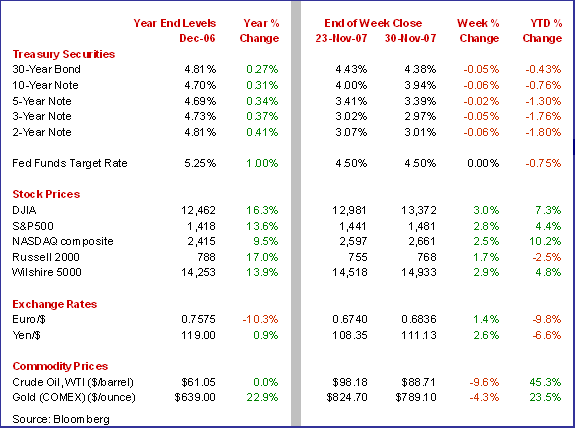
Weekly percent change column reflects percent changes for all components except interest rates. Interest rate changes are reflected in simple differences.
Economic data released this past week gave us a fantastic rear window view of the third quarter with GDP being revised up sharply. But more current data indicate that the economy is undergoing a broad-based slow-down at least temporarily.
While third quarter GDP is a little dated by now, the report does provide a good backdrop to better understand strengths and weaknesses in the current quarter. Third quarter real GDP was revised upward sharply to an annualized 4.9 percent from the initial estimate of 3.9 percent. The upward revision was primarily due to a higher estimate for inventory investment and for stronger net exports. The third quarter growth rate was the strongest since the 7.5 percent jump for the third quarter of 2003. Overall, the economy had strong momentum heading into the summer's credit crunch – at least outside of housing. If credit markets can improve, then the rest of the economy is in decent shape (other than housing. The biggest caveat – and it is not a large one – is that the inventory accumulation was a little on the high side but not dramatically so. The impact on U.S. manufacturing should be modest – especially since a good chunk of the inventory adjustment would come out of imports instead of just U.S. manufacturing.

There was little change in the quarterly inflation numbers. The GDP price index was revised upward slightly to an annualized 0.9 percent from the initial estimate of 0.8 percent. The core PCE price index was unrevised at an annualized 1.8 percent.
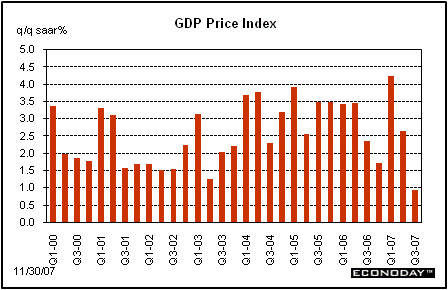
One facet of the economy that is likely of increasing concern to the Fed is the consumer sector. Various Fed officials have indicated in speeches that they expected some weak economic data in the fourth quarter and that has happened to a modest degree in personal income and personal spending. Unfortunately, inflation is on the high side also – meaning the Fed still has a touchy decision on whether to cut rates or not. Personal income slowed to a 0.2 percent rise in October, following a 0.3 percent increase the prior month. But more notable was the deceleration in the important wages and salaries component which weakened sharply to a 0.1 percent advance, following a 0.6 percent increase in September. Consumers spend primarily out of wages and salaries income and less so out of most other types of income such as dividends or interest income. Personal income on a year-on-year basis dipped to up 6.0 percent from up 6.5 percent in September.

On the spending side, the consumer is increasingly cautious. Personal consumption in October rose a modest 0.2, following a 0.3 percent increase in September. Weakness was primarily in durables. While the nominal or current dollar gain in personal consumption was soft, it was downright anemic in real terms. Constant dollar spending was flat in October, following a meager 0.1 percent gain in September. These numbers point to a very soft GDP figure for the fourth quarter since personal consumption typically makes up over 60 percent of GDP.
On the inflation front, the core PCE price index rose 0.2 percent in October, matching the increase in the prior month. The consensus forecast was for a for a 0.3 percent increase. The overall PCE price index increased 0.3 percent, the same as in September. On a year-on-year basis, the core rate came in at 1.9 percent, the same as in September. The overall PCE price index on the same basis jumped to 2.9 percent from 2.4 percent in September.

While Fedspeak has indicated that core inflation has been relatively well behaved in recent months, the core rate actually has been very incrementally rebounding from lows seen this past spring. On a 3-month-ago annualized basis, the core PCE inflation rate is now back up to 2.3 percent in October, compared to the recent low of 1.2 percent in May. The Fed will need a period of soft economic growth to bring that rate back down – especially since higher energy costs are still a concern.

Durable goods orders in October continued a recent downtrend, indicating that the economy is in a rough patch. Durable goods orders fell 0.4 percent in October, following a 1.4 percent decline in September. Excluding the transportation component, new orders fell 0.7 percent in October, following a 1.1 percent rebound in September.
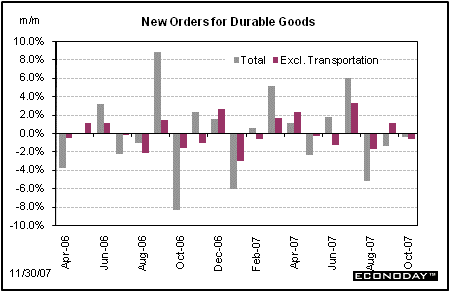
Weakness in durables orders in October was led by communications equipment and computers. The good news is that a number of industry categories were positive. Industry categories posting gains in October were primary metals, fabricated metal products, electrical equipment, and transportation. Weakness in manufacturing clearly is not pervasive. Were the economy headed into recession, the manufacturing sector would be leading the way and with broad-based declines.
New and existing home sales were mixed in direction on the margin in October but both clearly were at depressed levels. Sales of existing homes fell 1.2 percent in October to a new cyclical low of a 4.97 million annual pace which is the lowest since the current series began in 1999. But the worst news for existing home sales is that supply on the market – at 10.8 months – is a series record high. Poor sales are finally beginning to erode year-on-year prices, which are down 5.1 percent to a median $207,800. With foreclosure rates rising, housing markets are likely to be depressed for some time.

New home sales were little better than for existing homes. New home sales came in at an annual unit rate of 728,000 in October, compared against a steeply downward revised 716,000 in September that marks a nearly 12-year low. Year-on-year, new home sales are down 24 percent. One piece of good news is an easing in the glut of unsold new homes, at an 8.5 month supply vs. 9.0 months in September. Nonetheless, supply weighs heavily on builders and starts, and outlays are going to be weak for some time.
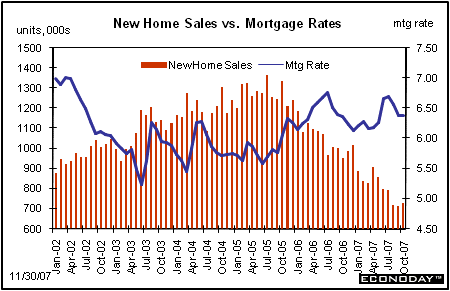
Bloated supply and slow sales are finally beginning to take prices down as median prices for new homes plunged 9 percent in October for a year-on-year decline of 13 percent. The median price is now $217,800 vs. $207,800 for existing homes (down 5.1 percent year-on-year). Falling home prices will limit refinancing, especially important given the rising volume of mortgage resets, and will hurt home-related demand.
Prior to further revelations about subprime losses this past week, Fed officials had been going out of their way to suggest that monetary policy after the October 31 rate cut was appropriate and that markets should not count on another rate cut in December. That thinking changed with remarks first by Fed Vice Chairman Kohn that the Fed needs to remain flexible heading into the December meeting and then corroborated by Chairman Bernanke. But other Fed officials may not agree that further easing is needed – Federal Reserve Bank of Philadelphia President Charles Plosser stated after Kohn’s and Bernanke’s remarks that the Fed cannot solve all problems of the U.S. economy – specifically pointing to the need for the markets to take care of pricing of sub-prime assets. The Fed and other regulators are going out of their way to address credit problems with a broad range of approaches – including encouraging mortgage lenders to find ways to limit upward adjustments of ARMs. The Fed may be leaning toward more of a cut in the discount rate than in the fed funds target rate. And we should not forget that the Fed has been clear about its expectations for the economy – very weak fourth quarter growth but with a rebound early in 2008. In that light, the Fed will be looking for ways to minimize rate cuts in order to ensure meeting its inflation target. In the mean time, there will be soft growth that markets may be ignoring.
This coming week’s highlight clearly is the November employment report due out on Friday. That will be the last big indicator before the Fed’s December 11 FOMC policy meeting.
The Institute for Supply Management’s manufacturing index slipped to 50.9 in October from 52.0 in September with production a real drag, down 5 points to 49.6. New orders were marginally positive with export orders healthy. However, a key warning of pending slowing in manufacturing was a jump in customer inventories. Prices paid were high, coming in at 63.0 versus 59.0 in September due to high oil prices. More recently, the Chicago purchasing managers index was moderately positive for November, indicating that manufacturing has not fallen off a cliff and remains viable.
ISM manufacturing index Consensus Forecast for November 07: 50.4
Range: 49.5 to 52.0
Motor vehicle sales were flat in October coming in at a 7.1 million annual unit rate for U.S.-made light trucks and a 5.0 million rate for U.S.-made cars, levels that are slightly lower than September. With income growth slowing and gasoline prices rising, sales are likely to be sluggish in November.
Motor vehicle sales Consensus Forecast for November 07: 12.1 million-unit rate
Range: 11.7 to 12.5 million-unit rate
Nonfarm productivity in the third quarter surged to an annualized 4.9 percent increase, following a 2.2 percent gain in the second quarter. With the upward revision to third quarter GDP by a full 1.0 percentage point to 4.9 percent, productivity is certainly going to be revised up also. The initial estimate for third quarter unit labor costs showed an annualized decline of 0.2 percent, following a 2.2 percent increase in the second quarter. Currently, productivity and labor costs look quite favorable toward inflation trends but the numbers can change in a hurry if output flattens as most expect for the fourth quarter.
Nonfarm Productivity Consensus Forecast for revised Q3 07: +5.7 percent
Range: +5.5 to +6.3 percent
Unit Labor Costs Consensus Forecast for revised Q3 07: -1.1 percent rate
Range: -2.1 to -0.7 percent rate
Factory orders advanced 0.2 percent in September, following a 3.5 percent drop the prior month. The boost in overall inventories was due to a gain in nondurables orders and largely reflected price increases for petroleum and coal. Nondurables orders were up 2.1 percent while durables dropped 1.7 percent in September. More recently, durables orders fell 0.4 percent in October with weakness led by communications equipment and computers.
Factory orders Consensus Forecast for October 07: 0.0 percent
Range: -0.5 to +0.6 percent
The business activity index from the ISM non-manufacturing survey rose to a very solid 55.8 in October from 54.8 in September. While manufacturing may be a little soft, the non-manufacturing sectors are holding relatively well. New orders were healthy, led by export orders. Interestingly, import orders were surprisingly strong, suggesting that businesses still expected the consumer sector to hold up. Inflation numbers eased slightly but remain elevated.
Business activity index Consensus Forecast for November 07: 54.8
Range: 53.0 to 56.0
Initial jobless claims jumped significantly in the week ending November 24 with no special factors to account for the disappointment. Claims surged 23,000 to 352,000, the highest level since February. The spike in claims means that the labor sector may not be as stable as many had believed and cannot be relied upon to support economic growth. The Fed will get to see one more claims report prior to the December 11 FOMC meeting but the latest numbers indicate that the economy certainly is in that “rough patch” that Fed officials have been anticipating.
Jobless Claims Consensus Forecast for 12/1/07: 335,000
Range: 325,000 to 335,000
Nonfarm payroll employment in October came in quite strong while wage inflation actually eased. Nonfarm payroll employment in October jumped 166,000, following revised increases of 96,000 in September and 93,000 in August. But initial unemployment claims have since risen and point toward sluggish job gains for November. Construction jobs are likely to post another decline along with manufacturing. And we could see some sizeable losses in financial services as a result of subprime fallout. Layoffs are likely to lead to a modest increase in the unemployment rate which came in unchanged at 4.7 percent in October. But look for a soft increase in wages, which posted a 0.2 percent rise in October, following a 0.3 percent boost in September. Only a very robust employment report would derail a Fed rate cut on December 11 and that is not likely.
Nonfarm payrolls Consensus Forecast for November 07: +65,000
Range: -10,000 to +100,000
Unemployment rate Consensus Forecast for November 07: 4.8 percent
Range: 4.8 to 4.8 percent
Average workweek Consensus Forecast for November 07: 33.8 hours
Range: 33.8 to 33.8 hours
Average hourly earnings Consensus Forecast for November 07: +0.3 percent
Range: +0.2 to +0.4 percent
The Reuter’s/University of Michigan’s Consumer sentiment index fell to 76.1 for November’s final reading from 80.9 for October. Consumer sentiment has been rattled by high gasoline prices, rising adjustable mortgage rates, uncertain stock markets, and slow job growth. But inflation expectations have not been lifted further as one-year inflation expectations showed no new pressures from mid-month, at 3.4 percent vs. October's 3.1 percent.
Consumer sentiment Consensus Forecast for preliminary December 07: 76.0
Range: 70.0 to 77.0
Consumer credit in September rose a modest $3.7 billion, compared to a $15.4 billion jump in August and well down from trend. Revolving credit rose $3.4 billion in the month, also well down from trend and suggesting that consumers are not relying more heavily on credit cards to make everyday payments. Non-revolving credit rose $0.3 billion in the month, well down from $8.4 billion in August. A combination of factors could be behind the slower credit growth, including soft motor vehicle sales, consumer caution about spending, less growth in home equity, and financial firms lending at a slower growth rate due to illiquidity in the credit markets and over concern about consumers being overextended.
Consumer credit Consensus Forecast for October 07: +$9.0 billion
Range: $2.0 billion to +$11.3 billion



|

